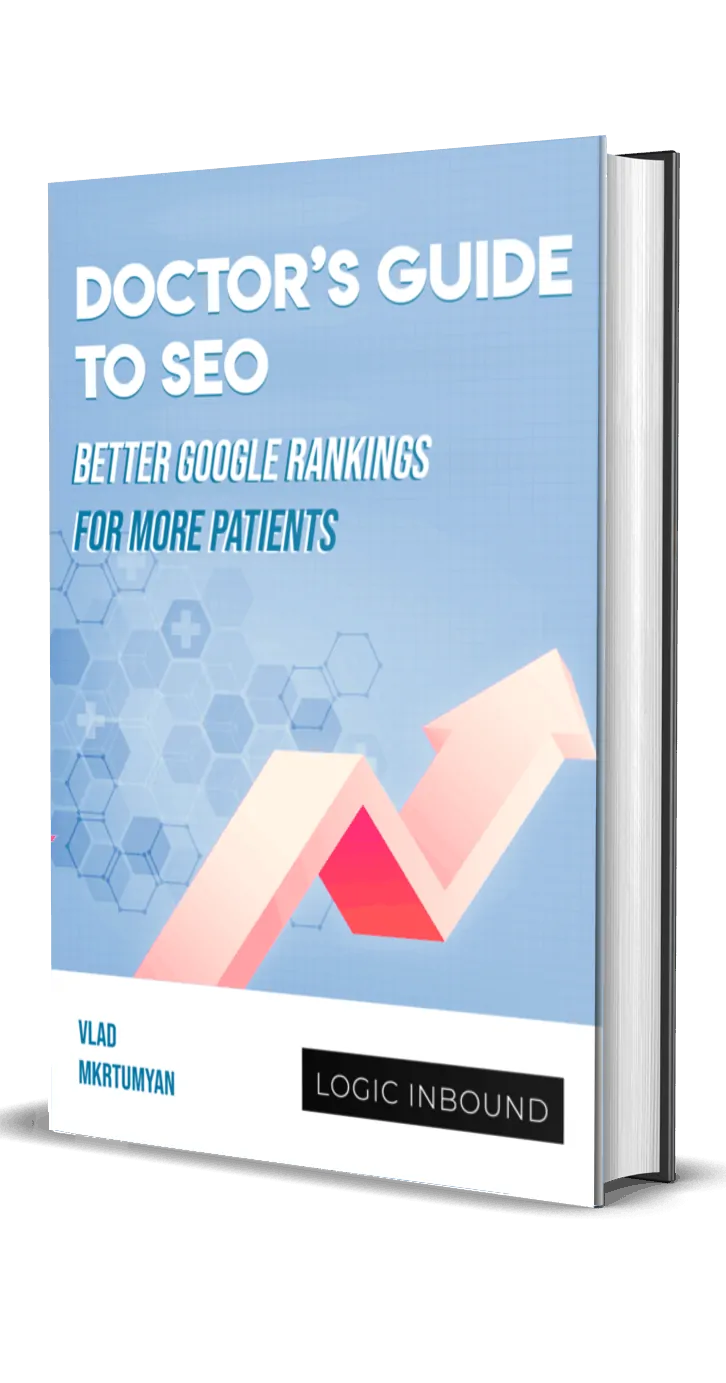If your business isn’t showing up on Google Maps, you’re probably making one of these 7 local SEO mistakes and it’s costing you real customers. Why does that matter so much?
Because roughly half of all people who search for a local business on their smartphone visit a store within a day, and 78% of those searches lead to an offline purchase, according to BrightLocal.
In other words, if you’re not showing up, you’re missing out on actual paying customers.
When someone in Seattle searches “plumber near me” or “best med spa in Seattle WA,” they’re not scrolling past the first few listings. They’re clicking the top result, calling the number, and booking a service. That’s what local SEO is all about, showing up first when it matters most.
But here’s the problem: most small businesses in Seattle are doing local SEO wrong without even knowing it. From outdated Google listings to missing reviews or inconsistent contact info, the same common mistakes show up again and again. And in 2025, they’re more expensive than ever.
Thanks to Google’s AI-powered summaries and the rise of zero-click search (nearly 60% of Google searches now end without any click), the margin for error is thinner than ever. Even one mistake can knock you out of the Map Pack. And once you’re gone from the local 3-pack, you’re practically invisible to the very customers ready to buy, after all, businesses in the 3-pack earn 126% more traffic and 93% more actions (calls, clicks, direction requests) than those ranking lower.
In this guide, you’ll learn:
- What those mistakes are
- How to fix them step-by-step
- Tools and Seattle-specific SEO tips to get your business found fast
We’ve even included a free checklist to audit your SEO like a pro.
Let’s fix what’s holding you back before your competitors take the lead.
What Are Local SEO Mistakes and Why They’re Costing You Leads
Local SEO isn’t some complex marketing theory. It’s the stuff that helps your business show up when someone searches things like “emergency plumber in Seattle” or “best med spa near me.” It’s how you land in Google’s local map results, which is where most of the calls and clicks actually happen.
Now, here’s the kicker: 46% of all Google searches are local. Nearly half. So if you’re not showing up when someone nearby is ready to hire, you’re not just missing traffic, you’re bleeding customers.
Most business owners don’t realize how easy it is to mess this up. A wrong phone number on Yelp. A Google Business Profile missing service areas. Or no reviews. These local SEO mistakes seem small, but they can push you off the map completely.
And in Seattle, where dozens of HVAC companies, roofers, and clinics are all fighting for the same spots, one slip-up can send your competitors straight to the top. Google’s proximity filter means even if you’re the best in town, you won’t rank if your info’s off, or worse, outdated.
The good news? These mistakes are fixable. And we’re about to show you how.
One wrong move and you’re invisible on Google. Let’s fix your local presence before competitors run away with your leads.
Mistake #1 – Ignoring NAP Consistency Across the Web
NAP stands for Name, Address, and Phone Number, and it matters more than most business owners think. Google uses your NAP details to verify that you’re a real, credible business. In fact, accurate NAP information across the web is still considered one of the top factors for local search rankings.
But if your info is mismatched across platforms? You’re sending Google mixed signals. And mixed signals get you ignored.
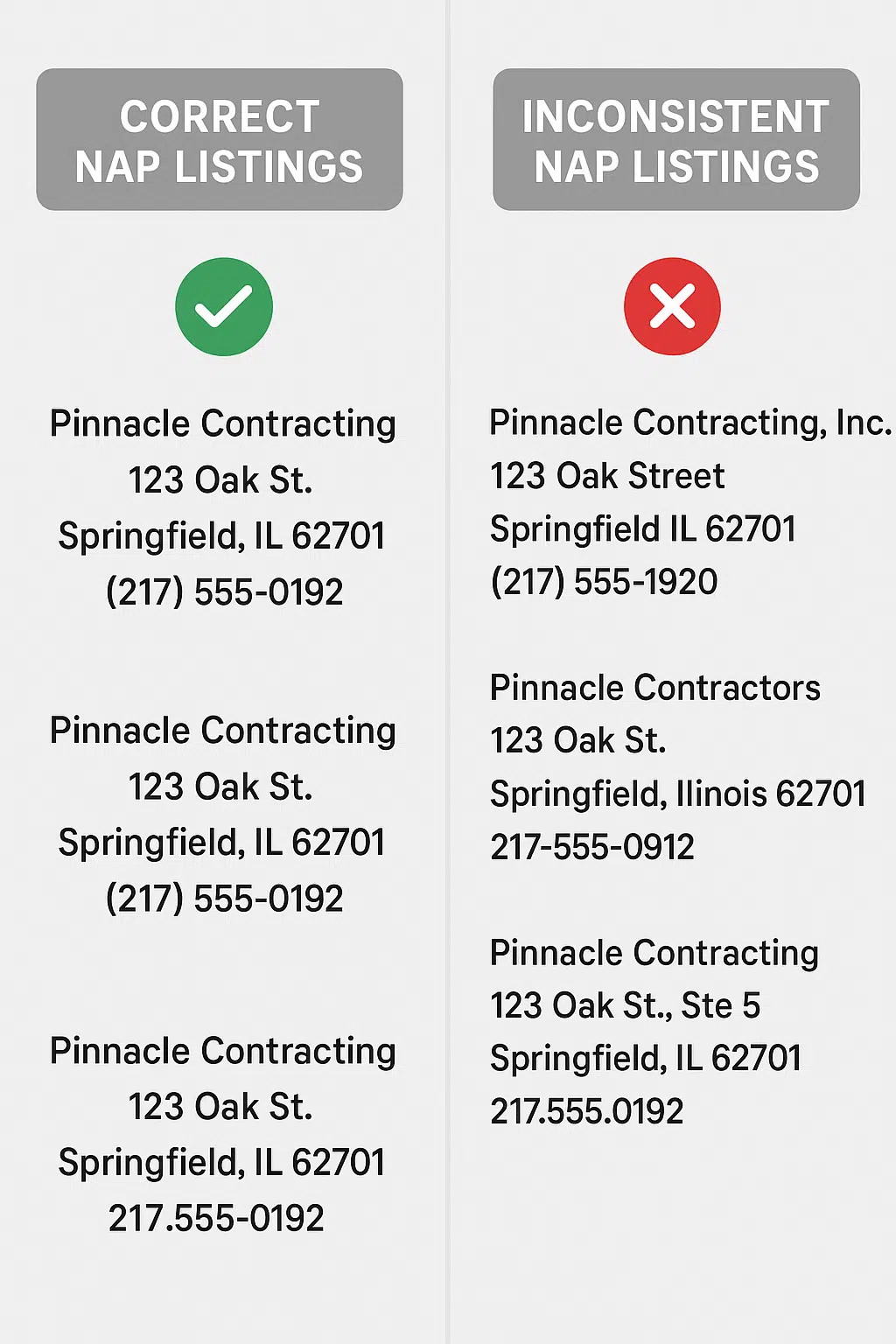
Let’s say your website says “123 Main St. Suite 200,” but your Yelp page just says “123 Main.” Or your phone number on YellowPages is your old line from two years ago. Even small differences like “Street” vs. “St.” or missing suite numbers can create confusion. Google sees that and says, “Hmm… is this one business or two?” That’s how common local SEO mistakes happen quietly, but with real consequences. And those consequences aren’t just about rankings, they affect customer trust too. In fact, 80% of consumers say they lose trust in a business when its online contact information is incorrect or inconsistent.
In Seattle, this matters a lot. The local map pack has limited slots. If your NAP isn’t locked in and consistent across directories like Yelp, BBB, Facebook, YellowPages, and your own website, you’re leaving room for your competitors to leap ahead. We’ve seen it time and time again.
So how do you fix it?
- Run a citation audit. Free tools like BrightLocal or Moz Local will scan your listings.
- Make a list of every place your business info appears online.
- Update each one manually, or outsource to a service (we do this at Logic Inbound, by the way).
- Keep a Google Sheet so nothing slips in the future.
Want an easier way to keep your local listings clean and consistent? Check out our affordable SEO services for small businesses that want to stop guessing and start ranking.
Mistake #2 – Not Optimizing Your Google Business Profile
If your Google Business Profile (GBP) still looks like it was thrown together in a hurry, or worse, hasn’t been touched since 2022, you’re probably missing out on calls, clicks, and customers. Consider that 64% of consumers have used the phone number on a Google Business Profile to contact a local business. On top of that, Google’s own data shows customers are 70% more likely to visit (and 50% more likely to buy) from businesses with a complete profile.
Your GBP is your local storefront on Google. It’s the first thing people see when they search “electrician near me” or “best dentist in Seattle.” Yet we constantly see local SEO mistakes like half-filled profiles, blurry logos, or services listed like someone gave up halfway through.
In 2025, Google has made things even spicier. With AI-generated business summaries, Google is now auto-writing descriptions based on your content, reviews, and website. That means if your profile is vague, outdated, or misaligned, Google could end up describing your business in a way that hurts more than it helps.
So, what does a well-optimized profile look like today?
- Accurate NAP info (you fixed that in Mistake #1, right?)
- Every service filled in, with categories that match your real offerings
- Photos with location metadata (yes, geotagged pics help rankings)
- Q&A section actively answered
- Appointment links or website buttons that actually work
- Review responses that show your business is alive and engaged
In a competitive city like Seattle, where search volume is high and the local pack is crowded, your GBP needs to be sharp. Google decides who ranks in that 3-pack based on proximity, relevance, and prominence. If you’re missing any one of those, you’re toast.
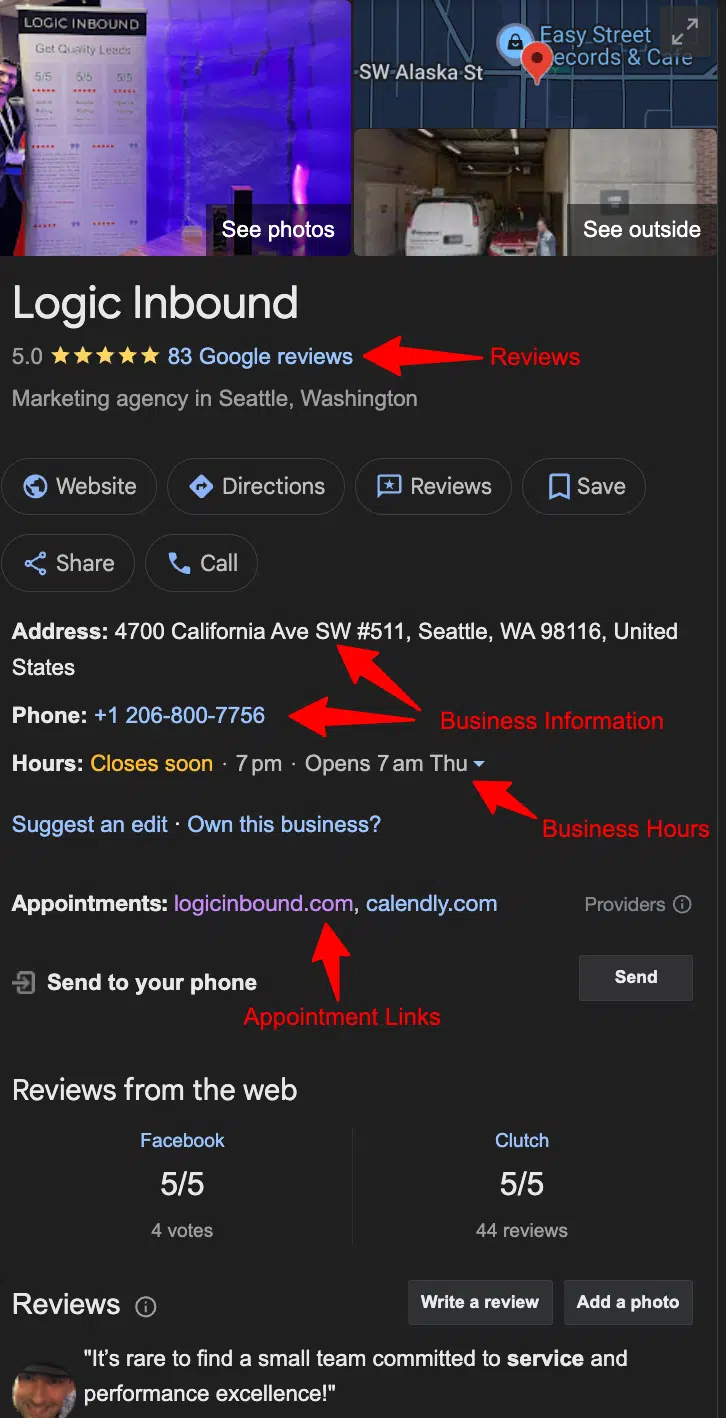
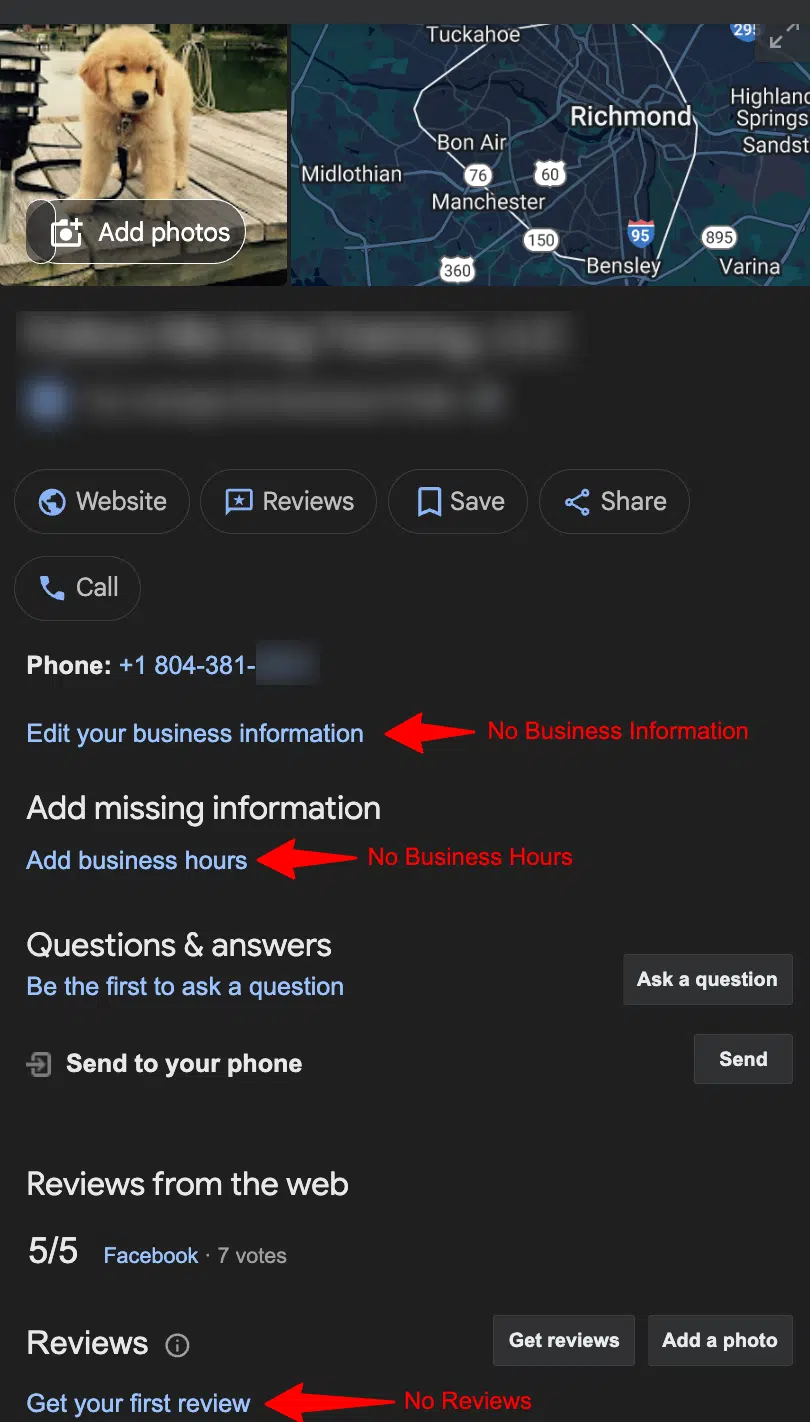
Optimized Google Business Profile
Unoptimized Google Business Profile
And if you’re wondering how paid visibility fits in, we also broke down how Google Local Services Ads play a role in boosting trusted local listings.
Not sure why your listing isn’t ranking? We broke it all down in this blog:
👉 Why is my business not showing up on Google
If you want to compete in Seattle local SEO, this is non-negotiable.
This isn’t just a profile. It’s a lead magnet, when you treat it right.
We’ve helped brands like Ticket Cutter grow their local visibility by dialing in every detail of their profile, from categories to geotagged photos and the results speak for themselves.
Mistake #3 – Building Zero Local Citations (or the Wrong Ones)
Let’s get one thing straight: Google’s algorithm may be smarter in 2025, but it still leans on the basics. And local citations? They’re still a big deal. In fact, research shows citations remain the fifth most significant ranking factor for Google’s local pack visibility.
If you’re new to the term, citations are simply mentions of your business across the web – usually your name, address, and phone number on directories like Yelp or the BBB. They act like references for your business. The more accurate and relevant they are, the more Google trusts you.
Here’s where it goes sideways: most Seattle businesses either don’t have enough citations, or worse, they’re listed in the wrong places. Like some dusty national directory no one’s heard of since 2014. That’s like handing Google a fake resume and expecting a job offer.
If you want to fix local SEO issues, especially in a competitive market like Seattle, you need citations in the right places. One study found that businesses listed on 30+ relevant sites saw a 136% boost in consumer actions (e.g. calls, clicks, direction requests). Start with these top Seattle-specific directories to build quality citations:
- Seattle Chamber of Commerce
- Seattle.gov local business listings
- Local blogs like Seattle Magazine, Seattle Eater or Seattle Met (for restaurants, services, and events)
And don’t forget the high-authority staples:
Want to save time?
Use tools like BrightLocal or Whitespark to scan your current citations, fix inconsistencies, and build new ones that actually move the needle.
Not sure where your listings stand or what’s worth fixing? Our local SEO services for contractors focus on practical fixes that generate real leads, not just vanity metrics.
Citations aren’t glamorous. But they’re the quiet workhorses of local SEO. And right now, your competitors are probably skipping them. Which gives you an edge, if you do it right.
Mistake #4 – Targeting Generic Keywords Instead of Location-Specific Ones
If you’re trying to rank in Seattle with keywords like “plumber” or “lawyer,” you’re basically yelling into a crowd of millions and hoping Google hears you.
Spoiler: it won’t.
Here’s what most local businesses get wrong. They focus on broad, generic keywords that are technically relevant, but completely useless without context. Google has gotten smarter. It knows when someone is looking for a local solution. And in 2025, it’s prioritizing pages that actually say where the service is offered. One industry analysis even observed a clear shift toward localized service pages appearing in search results instead of generic pages.
So instead of trying to rank for “plumber,” you need to rank for “plumber in Seattle” or “emergency plumber Seattle WA.” Those small tweaks signal to Google: this page is for people in this city, right now.
And if you serve multiple neighborhoods or cities? You need service-area pages for each one. This is a foundational piece of Seattle local SEO that most competitors still skip.
Here’s a quick cheat sheet to drive it home:
| Generic Keyword | Better Local Keyword | Search Intent |
| Plumber | Plumber in Seattle | Local |
| Dentist | Emergency dentist Seattle | Transactional |
| Lawyer | Family lawyer Seattle | Navigational |
Need help mapping out the right keywords for your industry? We walk through this process in our affordable SEO services for small businesses. It’s not just about traffic, it’s about leads that convert.
If you’re not tailoring your content to match real-world searches in your area, you’re missing one of the most actionable SEO tips for local businesses.
This is one of those local SEO mistakes that’s easy to fix and incredibly costly if you ignore it.
Want to outrank your local competitors in 30 days or less? Our proven keyword strategy has helped Seattle businesses dominate their niche.
Mistake #5 – Poor Mobile Experience (and No Voice Search Optimization)
Take a wild guess where most of your customers are searching from in 2025. Yep, their phones. In fact, over 60% of local searches happen on mobile. And yet, plenty of business websites still look like they were designed on a desktop in 2012… and tested on a flip phone.
Let’s be real. If your mobile site loads slow, buttons are too small, or forms break, you’re not just annoying users, you’re losing leads. That’s especially painful for service-based businesses, where customers are searching at the moment: “plumber open now,” “locksmith near me,” “emergency HVAC Seattle.”
Google’s not a fan either. Your mobile site is graded based on something called Core Web Vitals, a fancy way of measuring how fast your page loads, how quickly it responds, and how stable it looks as it loads. Fail those tests, and Google pushes your site down the results. That’s one of the easiest local SEO mistakes to fix, and one of the most ignored.
Now let’s talk about voice search. If you’ve ever asked your phone, “Who’s the best roofer near me open now?,”you’ve used it. And your potential customers are doing it every day. But most websites aren’t optimized for how real people speak. They stuff in short keywords instead of using natural, conversational phrasing like:
- “How much does it cost to replace a roof in Seattle?”
- “Best landscaper near me with free quotes”
- “Who does same-day water heater repairs?”
By building long-tail Q&A-style content and using schema markup, your site becomes voice-search friendly. That’s how you show up when Siri, Alexa, or Google Assistant answers the question.
We’ve also shared how to optimize your content for voice search in a recent AI search case study, and the same principles apply to local rankings.
If your site isn’t working well on mobile, and you’re not answering how people actually ask, it’s time to overhaul it.
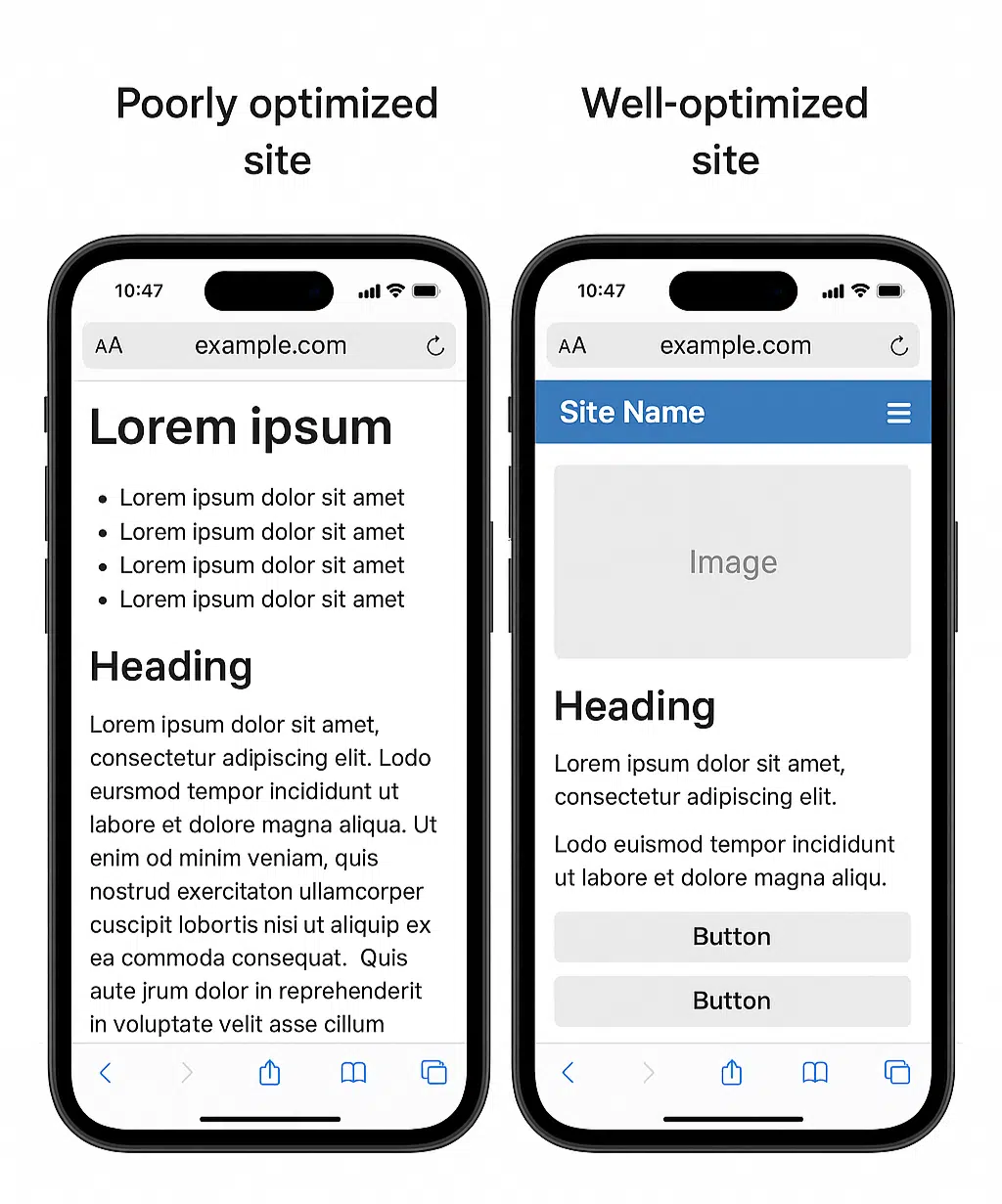
Mistake #6 – No Review Strategy (Or Worse, Fake Reviews)
Let’s face it: reviews are the new referrals.
When someone in Seattle searches for a service – plumber, chiropractor, or mobile detailer, they’re not calling the first listing. They’re calling the one with dozens of real reviews that sound like actual people. In fact, research shows up to 89% of consumers use online customer reviews when researching a product or service. If your listing has none, or worse, only your mom’s, you’re invisible.
Google doesn’t just show businesses with the most reviews; it highlights those with steady, authentic feedback (ideally across multiple platforms). In fact, the majority of consumers (about 74%) check at least two different websites for reviews, so it pays to diversify your review presence. And in 2025, things got a bit more…strict.
Thanks to smarter AI, Google now flags patterns that look suspicious (and it’s aggressive about it, in 2024 alone Google removed over 240 million fake reviews as part of a crackdown). Too many five-star reviews in one day? Could be fake. Asking only happy customers to leave feedback? That’s called review gating, and it can now tank your visibility.
This is one of the most avoidable local SEO errors, yet so many businesses still treat reviews like a nice-to-have instead of a ranking factor. Big mistake.
Here’s what works now:
- Add a review link to every invoice or receipt
- Send follow-up texts after a job is done (tools like Podium or NiceJob make this easy)
- Automate reminders after service via email or SMS
- Ask in person, but make it easy, QR codes work great in trucks or on front desks
- Most importantly: respond to all reviews (yes, even the weird ones)
If your business needs help setting up a real review system that doesn’t violate Google’s rules, our SEO audit service can show you exactly where the gaps are, no fluff, just data.
Oh, and fake reviews? They’ll get flagged eventually. And when they do, the fallout hits hard. Your best move? Be real, be consistent, and ask every time.
Mistake #7 – Not Tracking or Measuring Local SEO Performance
You wouldn’t drive blindfolded. So why are so many business owners flying blind with their local SEO?
If you don’t know where your leads are coming from, or worse, if they’re coming at all, how can you improve? One of the most overlooked SEO tips for local businesses is simple: track what matters. Not rankings. Not impressions. We’re talking about real stuff: clicks, calls, and customers.
This is where most small business owners miss the mark. They spend money on SEO or post to their Google Business Profile, but never look at the results. That’s one of the sneakiest local SEO mistakes because it feels productive… but gets you nowhere.
Here’s what you actually need to watch:
- Google Search Console shows what keywords people are finding you with
- Google Business Profile Insights shows views, calls, and direction requests
- Call tracking tools like CallRail help you tie every phone call to the source
- Bonus points for UTM-tagged links and goal tracking in GA4
If you run a Seattle service-based business, and you’re not seeing growth, it’s time to dig into your data. Only 28% of small businesses track their SEO ROI, and that’s a stat you don’t want to be part of.
At Logic Inbound, we give clients a clear snapshot of what’s working – broken down by calls, conversions, and real lead quality. We’ve done it for businesses in competitive cities like Seattle and delivered full transparency without the fluff.
In one campaign for a high-volume service brand, we discovered that a single keyword tweak increased booked calls by 32%, and they didn’t spend a dollar more on ads.
Stop guessing. Start ranking. Let our team show you exactly what’s missing in your local SEO.
Bonus: Free Local SEO Mistake Scorecard
Not sure where to start fixing your SEO? You don’t need a full-blown audit to catch the basics. You need a simple, no-fluff checklist and that’s exactly what we built.
Our Local SEO Mistake Scorecard is a self-audit tool that helps Seattle business owners quickly spot the most common problems. Use it to catch issues with your Google Business Profile, keyword targeting, review strategy, and more.
You’ll be able to check off items like:
- Is your NAP info consistent across the web?
- Have you claimed and optimized your Google Business Profile?
- Are you targeting city-specific keywords like “Seattle dentist” instead of just “dentist”?
- Is your site mobile-friendly and voice-search ready?
It’s fast, free, and built to help you stop guessing and start ranking.
If you’re looking for next steps once you’ve filled it out, check out our blog on improving your rankings with simple tweaks.
Why This Matters for Seattle Businesses Specifically
If you’re running a business in Seattle, the days of casually ranking for “roofer near me” are long gone. The city’s search competition has exploded. Whether you’re a plumber in Ballard or a chiropractor in Capitol Hill, everyone’s fighting for the same three spots in the map pack.
After Google’s Vicinity Update in 2023, the rules changed. Proximity became even more critical. Now, even a few blocks can make or break your visibility. That’s made Seattle local SEO more granular and more unforgiving than ever.
What does that mean for you?
It means that skipping reviews, neglecting citations, or letting your Google Business Profile collect digital dust isn’t just risky. It’s self-sabotage. Your competitors aren’t necessarily better, they’re just more dialed in.
For local service-based businesses, SEO isn’t just about traffic anymore. It’s your lifeline to leads, phone calls, and booked jobs. And in a city this competitive, showing up first is the difference between growth and ghost town.
Want a deeper look at how to build sustainable, local search visibility? Our guide to SEO for mold removal companies walks through one niche in detail, but the same principles apply across industries.
Want Help Fixing These Mistakes? Let Logic Inbound Handle It
You’ve seen the 7 local SEO mistakes. Now here’s the hard truth: if you’re making even a few of them, you’re probably losing leads every single week and not even realizing it.
Most Seattle business owners are too busy running their company to micromanage SEO, track listings, and respond to reviews. That’s where we come in.
At Logic Inbound, we specialize in Seattle local SEO for service-based businesses that need to rank, convert, and grow. We’ve helped contractors, clinics, and home service brands across the city dominate the map pack and we can do the same for you.
We have worked with several SEO companies over the years. When one expert left the industry, we were referred to Logic Inbound. This referral turned out to be the best decision we’ve made! Our online presence and relevance saw a significant improvement within the first year. Vlad and Hayk have been consistently available, and their reports are incredibly valuable. We have full confidence in their ongoing dedication to our success. Thanks to their efforts, our company has reached new heights!
It’s fast, actionable, and built to show you what’s working (and what’s not) before your competition gets ahead.
Let’s fix what’s holding you back, starting today.
FAQs About Local SEO (Seattle Edition)
- Why isn’t my business showing up on Google Maps?
There are a few reasons. Most commonly, your Google Business Profile isn’t fully optimized, your NAP info is inconsistent, or your business lacks relevance and prominence in Google’s local algorithm. If you’re not in the map pack, it’s not random, it’s a signal something needs fixing.
- What are the most common local SEO mistakes?
The biggest offenders are:
- Inconsistent contact info across platforms
- Missing or incomplete Google Business Profile
- No review strategy
- Weak or generic keyword targeting
- Lack of local citations
These local SEO errors quietly kill your visibility and they’re all fixable.
- How long does it take for local SEO to work?
Most businesses see early traction in 30 – 60 days, but competitive markets like Seattle often take 3 – 6 months for consistent lead flow. That’s assuming your site, citations, and GBP are properly optimized from the start.
- What’s the difference between local SEO and regular SEO?
Local SEO focuses on ranking for city-based or “near me” searches, like “Seattle electrician”. It’s all about showing up in the map pack and generating phone calls, not just website visits. Regular SEO is broader and targets national or informational keywords.
- Can I do local SEO myself or should I hire someone?
You can absolutely start it yourself using tools like:
- Google Business Profile
- BrightLocal
- Google Search Console
But if you’re short on time or need faster results, working with a local SEO agency like Logic Inbound helps you avoid costly trial and error. You’ll get measurable results without guessing.
